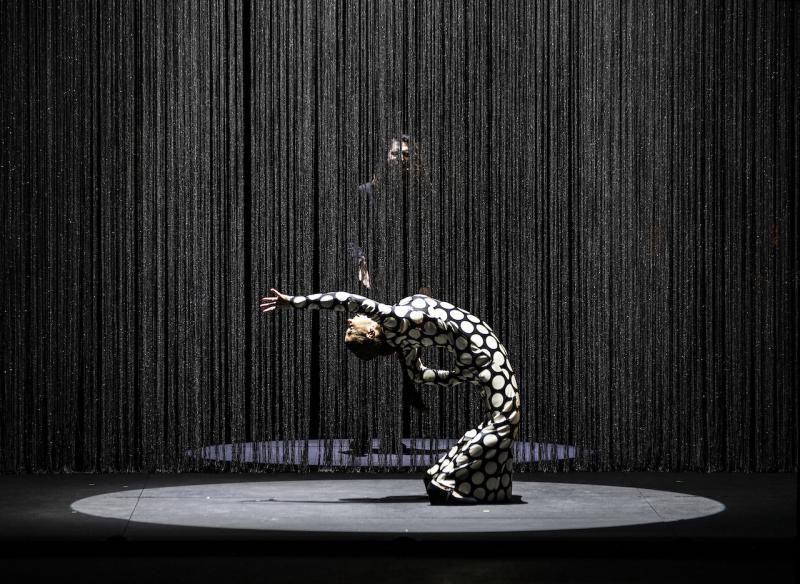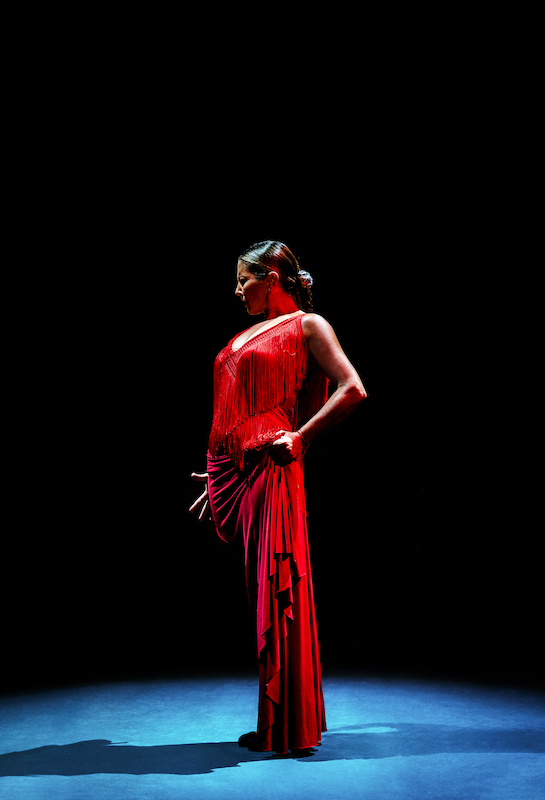Ballet Flamenco Sara Baras, Sadler's Wells - a roaring start to the Flamenco Festival | reviews, news & interviews
Ballet Flamenco Sara Baras, Sadler's Wells - a roaring start to the Flamenco Festival
Ballet Flamenco Sara Baras, Sadler's Wells - a roaring start to the Flamenco Festival
The reigning queen of zapateado shows us her soul

When flamenco first came out of the shadows and started to fill big theatres, it was like something out of a historical pageant. The shows that played London in the early 1990s harked back to an imagined gypsy past where old men hammered rhythms on blacksmiths’ anvils and women swirled extravagant frills. The crudely amplified music lost much of its detail but audiences lapped it up anyway.
Now garlanded with major awards over three decades Baras has nothing to prove in terms of technique. This seems to have liberated her – to try new ideas and find new depths in the art form. Previous shows she has brought to Sadler’s Wells have wowed with their stagecraft and virtuosity. The latest, Alma (“soul”), has that and more, and it’s the “more” that is almost impossible to describe. It remains a mystery how a dance form that is basically a confection of rhythmic feet and twining arms can deliver something akin to a religious high, but there are long stretches of this show that touch something rare and ineffable. Two hours (without interval) have never felt so short.
 Baras’s genius has been to modernise without losing sight of flamenco’s core values. In Alma, one of her experiments is to bring the obsolete Bolero back into currency as a song-and-dance form. Another is an extended call-and-response improv with saxophonist Diego Villegas, who makes you forget the instrument’s affinity with jazz as he riffs across its three-octave range in a distinctly different accent. Another specialty of Baras (pictured right) is the sense of community she creates around her. I doubt there’s another superstar who’d dress their backing chorus in slinky frocks identical to hers, or copy their moves while awaiting her solo cues. Typically, the musicians are all men – who needs a female vocalist when you’ve got Israel Fernández swooningly beautiful falsetto? – but the supporting dancers are almost all female. Daniel Saltares gets a cheer for being the token hombre. It’s a tough gig, given that some of the time Baras leaves him standing like a lemon while she duets with one of the women.
Baras’s genius has been to modernise without losing sight of flamenco’s core values. In Alma, one of her experiments is to bring the obsolete Bolero back into currency as a song-and-dance form. Another is an extended call-and-response improv with saxophonist Diego Villegas, who makes you forget the instrument’s affinity with jazz as he riffs across its three-octave range in a distinctly different accent. Another specialty of Baras (pictured right) is the sense of community she creates around her. I doubt there’s another superstar who’d dress their backing chorus in slinky frocks identical to hers, or copy their moves while awaiting her solo cues. Typically, the musicians are all men – who needs a female vocalist when you’ve got Israel Fernández swooningly beautiful falsetto? – but the supporting dancers are almost all female. Daniel Saltares gets a cheer for being the token hombre. It’s a tough gig, given that some of the time Baras leaves him standing like a lemon while she duets with one of the women.
I used to wonder why flamenco shows didn’t print out translations of the lyrics for the benefit of non-Spanish speakers, but in truth it’s not hard to get the gist of the songs. The words for “night”, “death”, “heart” and “dream” repeat with Duolingo insistence. Harder to grasp are the different musical forms, each with its own system of rhythmic handclaps - Seguiriya, Bulería, Soleá .… In the more sophisticated flamenco shows – those devised by Baras, or by the guitarist Paco Pena – the dances often segue so seamlessly that learning to distinguish them seems a hopeless task.
Bulería is the easiest to recognise. It’s the party number, licencing the dancer to shrug off the hauteur and have some fun. Baras is a joy as she hoists her long fringed skirts to rattle her steel-capped heels around the stage like a toy locomotive, pausing only to kick an imaginary stone from her path. Although the movement of her feet is barely visible, their rhythmic complexity surpasses anything a drummer could do, and it whips up the audience to screaming pitch. Yet the images of Baras that linger are from the quiet moments – like the time she lays an antique shawl on the ground and broods over it as if it were a corpse, or the time she simply stops dancing to stoop and touch the floor, as if to thank it for relaying her messages. Learning about flamenco, for a gringo like me, is a lifelong journey, and Baras a wonderful teacher.
The future of Arts Journalism
You can stop theartsdesk.com closing!
We urgently need financing to survive. Our fundraising drive has thus far raised £49,000 but we need to reach £100,000 or we will be forced to close. Please contribute here: https://gofund.me/c3f6033d
And if you can forward this information to anyone who might assist, we’d be grateful.

Subscribe to theartsdesk.com
Thank you for continuing to read our work on theartsdesk.com. For unlimited access to every article in its entirety, including our archive of more than 15,000 pieces, we're asking for £5 per month or £40 per year. We feel it's a very good deal, and hope you do too.
To take a subscription now simply click here.
And if you're looking for that extra gift for a friend or family member, why not treat them to a theartsdesk.com gift subscription?
more Dance
 'We are bowled over!' Thank you for your messages of love and support
Much-appreciated words of commendation from readers and the cultural community
'We are bowled over!' Thank you for your messages of love and support
Much-appreciated words of commendation from readers and the cultural community
 Giselle, National Ballet of Japan review - return of a classic, refreshed and impeccably danced
First visit by Miyako Yoshida's company leaves you wanting more
Giselle, National Ballet of Japan review - return of a classic, refreshed and impeccably danced
First visit by Miyako Yoshida's company leaves you wanting more
 Quadrophenia, Sadler's Wells review - missed opportunity to give new stage life to a Who classic
The brilliant cast need a tighter score and a stronger narrative
Quadrophenia, Sadler's Wells review - missed opportunity to give new stage life to a Who classic
The brilliant cast need a tighter score and a stronger narrative
 The Midnight Bell, Sadler's Wells review - a first reprise for one of Matthew Bourne's most compelling shows to date
The after-hours lives of the sad and lonely are drawn with compassion, originality and skill
The Midnight Bell, Sadler's Wells review - a first reprise for one of Matthew Bourne's most compelling shows to date
The after-hours lives of the sad and lonely are drawn with compassion, originality and skill
 Ballet to Broadway: Wheeldon Works, Royal Ballet review - the impressive range and reach of Christopher Wheeldon's craft
The title says it: as dancemaker, as creative magnet, the man clearly works his socks off
Ballet to Broadway: Wheeldon Works, Royal Ballet review - the impressive range and reach of Christopher Wheeldon's craft
The title says it: as dancemaker, as creative magnet, the man clearly works his socks off
 The Forsythe Programme, English National Ballet review - brains, beauty and bravura
Once again the veteran choreographer and maverick William Forsythe raises ENB's game
The Forsythe Programme, English National Ballet review - brains, beauty and bravura
Once again the veteran choreographer and maverick William Forsythe raises ENB's game
 Sad Book, Hackney Empire review - What we feel, what we show, and the many ways we deal with sadness
A book about navigating grief feeds into unusual and compelling dance theatre
Sad Book, Hackney Empire review - What we feel, what we show, and the many ways we deal with sadness
A book about navigating grief feeds into unusual and compelling dance theatre
 Balanchine: Three Signature Works, Royal Ballet review - exuberant, joyful, exhilarating
A triumphant triple bill
Balanchine: Three Signature Works, Royal Ballet review - exuberant, joyful, exhilarating
A triumphant triple bill
 Romeo and Juliet, Royal Ballet review - Shakespeare without the words, with music to die for
Kenneth MacMillan's first and best-loved masterpiece turns 60
Romeo and Juliet, Royal Ballet review - Shakespeare without the words, with music to die for
Kenneth MacMillan's first and best-loved masterpiece turns 60
 Help to give theartsdesk a future!
Support our GoFundMe appeal
Help to give theartsdesk a future!
Support our GoFundMe appeal
 Vollmond, Tanztheater Wuppertal Pina Bausch + Terrain Boris Charmatz, Sadler's Wells review - clunkily-named company shows its lighter side
A new generation of dancers brings zest, humour and playfulness to late Bausch
Vollmond, Tanztheater Wuppertal Pina Bausch + Terrain Boris Charmatz, Sadler's Wells review - clunkily-named company shows its lighter side
A new generation of dancers brings zest, humour and playfulness to late Bausch

Add comment